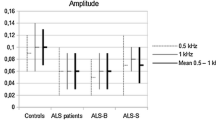Summary
It is frequently taken for granted that the acoustically evoked stapedius reflex is bilaterally symmetrical. Contrary to this, Møller described an asymmetry of the acoustic stapedius reflex with an ipsilaterally 2–14 dB lower threshold. The determination of normal values of the ipsilateral acoustic stapedius reflex threshold with a large number of patients is difficult as the intensity of the stimulus depends considerably on the position of the probe in the acoustic meatus and is therefore not defined with sufficient accuracy.
For this reason we determined the values of the ipsilateral threshold by applying a stimulus sound of high intensity to the deaf ear of unilaterally completely deaf patients with a normal headphone, which can be calibrated much more accurately. After subtraction of the individual cross hearing loss, the exact ipsilateral intensity was obtained. By this method a stapedius reflex could be evoked with 49 of the 62 patients. By mathematical consideration of the data of the positive cases, as well as the maximum available intensities with the negative cases, determination of the median value of the ipsilateral threshold was possible: at 0.5 kHz 59 dB; at 1 kHz 62.5 dB; at 2 kHz 67 dB; at 4 kHz approx. 67 dB. The difference between ipsilateral and contralateral stapedius reflex threshold was in the range of 15 dB. A new definition of the normal value for the ipsilateral measured Metz recruitment appears necessary.
Zusammenfassung
Häufig wird eine bilateral symmetrische Auslösbarkeit des akustisch ausgelösten Stapediusreflexes angenommen. Dagegen wurde eine Asymmetrie des akustischen Stapediusreflexes beim Menschen mit einer ipsilateral um 2–14 dB niedrigeren Schwelle von Møller beschrieben. Die Bestimmung von Normwerten der ipsilateralen akustischen Stapediusreflexschwelle bei einem klinischen größeren Patientengut steht unter der Schwierigkeit, daß die Intensität des Reiztones erheblich vom jeweiligen Sondensitz im Gehörgang abhängt und damit nicht genau genug definiert ist.
Wir haben deswegen die Werte der ipsilateralen Schwelle dadurch bestimmt, daß bei einseitig völlig tauben Patienten ein Reizton hoher Intensität von einem üblichen, gut eichbaren Kopfhörer auf das taube Ohr gegeben wurde. Nach Abzug des individuellen Überhörverlustes ergab sich exakt die ipsilaterale Intensität. Bei 49 von 62 Patienten war mit dieser Methodik ein Stapediusreflex auslösbar. Durch Berechnung nach den Daten der positiven Fälle und des Wertes der maximal verfügbaren Intensitäten bei den negativen Fällen ließ sich der Normwert (Medianwert) der ipsilateralen Schwelle ermitteln: bei 0,5 kHz 59 dB; bei 1 kHz 62,5 dB; bei 2 kHz 67 dB; bei 4 kHz ca. 67 dB. Die Differenz von ipsilateraler und kontralateraler Stapediusreflexschwelle lag im Bereich von 15 dB. Eine neue Definition des Normwertes für ipsilateral gemessenes Metz-Recruitment scheint erforderlich.
Similar content being viewed by others
References
Borg, E.: Acoustic middle ear reflexes: a sensory-control system. Acta oto-laryng. (Stockh.) (Suppl.) 304, 1 (1972)
Borg, E., Møller, A. R.: Effect of ethylalcohol and pentobarbital sodium on the acoustic middle ear reflex in man. Acta oto-laryng. (Stockh.) 64, 415 (1967)
Borg, E., Zakrisson, J. E.: Stapedius reflex and monaural masking. Acta oto-laryng. (Stockh.) 78, 155 (1974)
Djupesland, G.: Discussion. Acta oto-laryng. (Stockh.) (Suppl.) 224 (1967)
Djupesland, G., Flottorp, G., Sundby, A., Szalay, M.: A comparison between middle-ear muscle reflex thresholds for bone- and air-conducted pure tones. Acta oto-laryng. (Stockh.) 75, 178 (1973)
Eliasson, S., Gisselson, L.: Electromyographic studies of the middle ear muscles of the cat. EEG Clin. Neurophysiol. 7, 399 (1955)
Esser, G.: Diskussionsbemerkung. Arch. klin. exp. Ohr.-, Nas.- u. Kehlk.-Heilk. 202, 480 (1972)
Klockhoff, I.: Middle ear muscle reflexes in man. Acta oto-laryng. (Stockh.) (Suppl.) 164, 1 (1961)
Leitner, H.: Personal communication 1971/1975
Lidén, G., Peterson, J. L., Harford, E. R.: Simultaneous recording of changes in relative impedance and air pressure during acoustic and non-acoustic elicitation of the middle-ear reflexes. Acta oto-laryng. (Stockh.) 263, 208 (1970)
Metz, O.: Studies on the contraction of the tympanic muscles as indicated by changes in the impedance of the ear. Acta oto-laryng. (Stockh.) 39, 397 (1951)
Møller, A. R.: Bilateral contraction of the tympanic muscles in man. Ann. oto-rhino-laryng. 70, 735 (1961)
Reker, U.: Zum diagnostischen Wert der Stapedius-Reflex-Schwelle. HNO 24, 236 (1976)
Wever, E. G., Vernon, J. A.: The effects of the tympanic muscle reflexes upon sound transmission. Acta oto-laryng. (Stockh.) 45, 433 (1955)
Author information
Authors and Affiliations
Rights and permissions
About this article
Cite this article
Reker, U. Normal values of the ipsilateral acoustic stapedius reflex threshold. Arch Otorhinolaryngol 215, 25–34 (1977). https://doi.org/10.1007/BF00463188
Received:
Issue Date:
DOI: https://doi.org/10.1007/BF00463188




